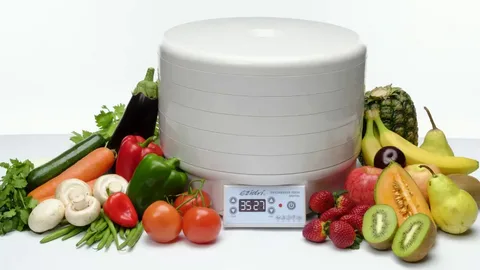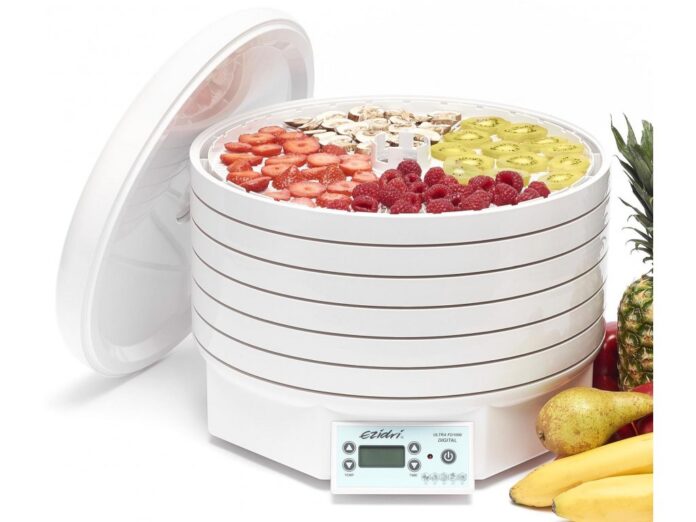Investing in a food-dehydrator is the way to go if you’re looking to extend the shelf life of your fruits, vegetables, and meats while retaining their nutrients and flavours. A food-dehydrator is a fantastic kitchen appliance that removes moisture from food to help preserve it for more extended periods. In this blog post, we will explore the benefits of using a food dehydrator, share tips and tricks for effective food dehydration, discuss the environmental impact of this preservation method, and provide you with some creative recipes to try at home.
Understanding the Basics of Food Dehydration
Food dehydration is a preservation method where water is extracted from food, vastly extending its shelf life by inhibiting the growth of bacteria, yeast, and moulds that thrive in moisture. A food-dehydrator circulates warm, dry air across the food, steadily evaporating the moisture it contains. This drying process can vary in duration, typically spanning several hours, influenced by the food item’s nature and the volume being processed.
Effective dehydration hinges on maintaining a consistent temperature and airflow around the food, ensuring moisture is uniformly removed. This method not only aids in preserving food for extended periods but also maintains its nutritional content and flavour, distinguishing it from other techniques that may compromise these qualities.
The Key Benefits of Using a Food-Dehydrator
One of the principal advantages of employing a food-dehydrator is preserving the nutritional content of foods. Unlike alternative preservation methods that may compromise the vitamins and minerals found in fresh produce, dehydration maintains these essential nutrients, providing a healthier snacking option.
Furthermore, dehydrated foods offer unparalleled convenience, both lightweight and compact, making them ideal for outdoor activities such as camping or hiking, where weight is a concern. This aspect also translates to more efficient storage solutions at home, as dehydrated produce requires significantly less space than its fresh or tinned counterparts, catering well to those with limited pantry space. In addition to these practical benefits, utilising a food-dehydrator opens up many culinary possibilities.
From crafting homemade fruit leathers devoid of added sugars and preservatives to producing your bespoke blend of dried herbs and spices, the versatility of a food-dehydrator encourages culinary creativity. This appliance serves as a food preservation tool and a gateway to exploring new and exciting flavours while fostering a more sustainable approach to food consumption and storage.
Tips and Tricks for Effective Food Dehydration
Achieving optimal results from your food-dehydrator involves more than simply slicing up your favourite fruits and vegetables and switching on the machine. Here are some practical tips and tricks to ensure successful food dehydration every time. It’s crucial to slice your food items uniformly. Consistent thickness means even drying, preventing some pieces from being overly dry while others remain too moist.
Pre-treatment can also significantly affect the quality of your dehydrated goods. For instance, blanching vegetables before dehydration can help preserve their colour and nutrients, while dipping fruits like apples and bananas in lemon juice can prevent browning. Arranging your slices in a single layer without overlap is essential for air to circulate effectively, ensuring even dehydration.
To maximise efficiency, consider the water content of the dehydrated foods. High-moisture items like tomatoes take longer to dry than herbs or mushrooms, so grouping foods with similar drying times can be more energy-efficient. Keeping a keen eye on the drying process and making adjustments based on humidity and temperature conditions can significantly enhance the outcome of your dehydrated treats.
Choosing the Right Dehydrator for Your Needs
Selecting the perfect dehydrator can be crucial for enhancing your food preservation endeavours. The size of the appliance is paramount, especially if you’re working with limited kitchen space or plan to dehydrate large batches of food. A compact model might suit smaller kitchens or modest dehydration needs. In contrast, a larger unit with extensive capacity is ideal for avid gardeners or families looking to preserve bulk produce.
Trays are another aspect to consider; more trays mean more surface area to spread out your fruits, vegetables, and meats but also require more storage space. Look for models that offer stackable trays or expandable options to accommodate varying quantities of food. Temperature control is a vital feature that allows for precise dehydration, catering to the specific needs of different types of food.
Adjustable settings ensure that delicate herbs can be dried at lower temperatures to preserve their oils and aromas, while higher settings are necessary for efficiently dehydrating meat. Some dehydrators have modern conveniences such as timers and automatic shut-off mechanisms. These features can be particularly beneficial for those with busy lifestyles, enabling them to dehydrate food overnight or while away from home without worrying about over-drying.
Creative Recipes to Try With Your Food-Dehydrator
Unleash your culinary creativity and experiment with many delightful recipes using your dehydrator. For a sweet treat, homemade fruit leathers are an excellent choice; blend your favourite fruits, pour the mixture onto dehydrator sheets, and wait for the magic. You’ll have a healthy snack without the unnecessary additives in shop-bought versions.
For the carnivores, why not try your hand at making beef jerky? Season slices of lean meat with a mix of spices and let them dry until they achieve that perfect chewy texture. Vegetable crisps can be a fantastic alternative to conventional crisps, offering a nutrient-packed munch. Slice vegetables thinly, season lightly, and dehydrate for a crispy, satisfying snack.
Please don’t overlook the possibility of drying herbs from your garden, preserving their aroma and flavour for your cooking throughout the year. These recipes are just the starting point; with a food-dehydrator, you can explore an endless array of dishes, each offering a unique taste and texture to delight your palate.
The Environmental Impact of Food Dehydration
The process of food dehydration offers not only a variety of benefits for your larder but also impacts the environment in several positive ways. Below are some key points that highlight the environmental benefits of using a food-dehydrator:
Reduces Food Waste
Food-dehydrators significantly reduce the amount of food in landfills by extending the shelf life of perishable items such as fruits, vegetables, and meats. This not only lessens the emission of greenhouse gases from decomposing food but also contributes to a more sustainable use of our food resources.
Lowers Energy Consumption
Food dehydration is relatively energy-efficient compared to other food preservation methods, such as freezing. Once the dehydration process is complete, foods do not require continuous energy to remain preserved, unlike frozen foods that require constant refrigeration, thus reducing overall energy usage in the long term.
Minimises Packaging Waste
Dehydrated foods require less packaging material than their fresh or canned counterparts. By reducing the need for plastic and other packaging materials, food dehydration helps decrease the volume of waste that contributes to landfills and ocean pollution.
Promotes the Use of Seasonal and Local Produce
Encouraging the dehydration of seasonal fruits and vegetables supports local agriculture and reduces the carbon footprint of transporting food long distances. This benefits the environment by lowering CO2 emissions and promotes a healthier, locally sourced diet.
Dehydrated Snacks for On-The-Go
Dehydrated snacks are an unbeatable choice for anyone seeking nutritious and convenient options whilst travelling, engaging in outdoor activities, or simply needing a quick snack during a hectic day. These snacks, ranging from crunchy banana chips to savoury vegetable crisps and energising trail mix, offer a delightful array of flavours and textures. Unlike shop-bought snacks laden with sugars and artificial preservatives, homemade dehydrated snacks are crafted from natural ingredients, ensuring you’re consuming healthy, wholesome food.
They are incredibly lightweight and compact, making them easy to pack and carry without the risk of spoilage. For those with adventurous palates, dehydrating different fruits, vegetables, and meats can uncover a whole new world of snack options. The possibilities are endless, whether it’s tangy dried apple slices, spicy meat strips, or a customised mix of dried fruits and nuts. These snacks satiate hunger and provide essential nutrients and energy, proving indispensable companions for on-the-go moments.
Proper Maintenance and Cleaning Of Your Food Dryer
Maintaining your food-dryer in optimal condition is pivotal for ensuring it continues to perform at its best. After each dehydration session, it is crucial to promptly remove any remnants of food from the trays to prevent any build-up of residues. The trays should be submerged in warm, soapy water and gently scrubbed to remove lingering particles or oils. Rinsing thoroughly under clean water ensures no soap residue is left behind.
The interior of the food dryer warrants attention, too. A soft, damp cloth can be employed to wipe down the surfaces, eliminating any food particles that may have settled. This step is essential not only for cleanliness but also for preventing any potential contamination during subsequent uses. Furthermore, attention should be paid to the food-dryer’s air vents and fans.
These components are integral to the device’s function, facilitating the flow of air necessary for dehydration. Checking these areas for obstructions and using a soft brush or cloth to clean them gently will help maintain proper airflow, ensuring efficient operation. It’s also advisable to consult the manufacturer’s instructions for specific maintenance guidelines, as certain models may have unique features or recommendations for care.
Conclusion
Embracing the art of food dehydration offers many benefits, from enhancing food’s shelf life and preserving its nutritional value to fostering culinary creativity and supporting sustainable living practices. Whether a novice looking to make healthier snack choices or an avid gardener aiming to reduce food waste, a food-dehydrator can be a valuable addition to your kitchen. By applying the tips and exploring the recipes mentioned, you can embark on a fulfilling journey of making dehydrated foods that are not only delicious but also beneficial for the environment.
FAQs
1. How does a food-dehydrator work?
A food-dehydrator works by circulating air evenly and consistently at a low temperature to remove moisture from food items. It typically consists of trays where sliced fruits, vegetables, or meats are placed. The dehydrator then slowly draws out moisture from the food, preserving it by inhibiting the growth of bacteria and mould.
2. What foods can you dehydrate with a food dehydrator?
A food dehydrator can dehydrate a wide range of foods, including fruits like apples, bananas, and berries, vegetables like tomatoes, peppers, and mushrooms, and meats like jerky and fish. You can also dehydrate herbs and nuts and even make fruit leathers or vegetable chips.
3. How long does dehydrate food with a dehydrator take?
The time required to dehydrate food with a food-dehydrator varies depending on factors such as the type of food, thickness of slices, and humidity levels. It can take a few hours to a day or more to fully dehydrate food. Thicker slices and higher moisture content will require longer drying times.
4. Is it necessary to rotate trays in a food-dehydrator?
Yes, rotating trays in a food-dehydrator are recommended for even drying. Since the airflow may not be uniform throughout the dehydrator, rotating trays ensure that all food items dry evenly. This helps prevent some items from becoming overly dry while others remain moist.
5. What are the benefits of using a food-dehydrator?
Using a food-dehydrator offers several benefits, including the preservation of food without the use of preservatives, the ability to create healthy snacks, the reduction of food waste by prolonging shelf life, and the convenience of making homemade dried foods.
| Other Good Articles to Read |
| Blogs-Nation |
| Blogs-Peoples |
| Bryan Smith Blogs |
| Intellect Blogs |
| The Fault In Our Blogs |
| Blogs Eu |
| Oz Forums |
| Recruitment Blogs |
| Zet Blogs |
| Id Blogs |
| Blogs Tudiolegale |
| Related Business Listings |
| Contact Directory |
| Local Business Profiles |

